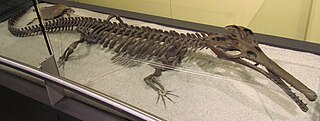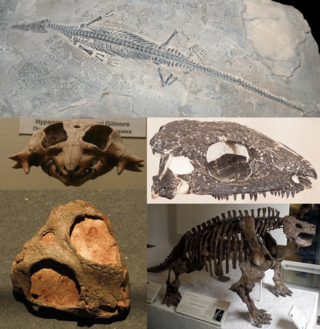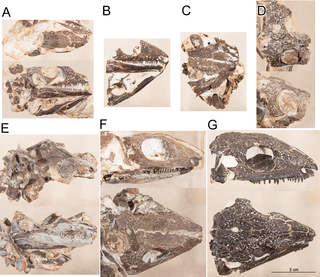
Dimetrodon is an extinct genus of non-mammalian synapsid belonging to the family Sphenacodontidae that lived during the Cisuralian age of the Early Permian period, around 295–272 million years ago. With most species measuring 1.7–4.6 m (5.6–15.1 ft) long and weighing 28–250 kg (62–551 lb), the most prominent feature of Dimetrodon is the large neural spine sail on its back formed by elongated spines extending from the vertebrae. It was an obligate quadruped and had a tall, curved skull with large teeth of different sizes set along the jaws. Most fossils have been found in the Southwestern United States, the majority of these coming from a geological deposit called the Red Beds of Texas and Oklahoma. More recently, its fossils have also been found in Germany and over a dozen species have been named since the genus was first erected in 1878.

Champsosaurus is an extinct genus of crocodile-like choristodere reptile, known from the Late Cretaceous and early Paleogene periods of North America and Europe (Campanian–Paleocene). The name Champsosaurus is thought to come from champsai, (χαμψαι) said in an Ancient Greek source to be an Egyptian word for "crocodiles", and sauros, (σαύρος) Greek for "lizard". The morphology of Champsosaurus resembles that of gharials, with a long, elongated snout. It was native to freshwater environments where it likely preyed on fish, similar to living gharials.

Diadectes is an extinct genus of large reptiliomorphs or synapsids that lived during the early Permian period. Diadectes was one of the first herbivorous tetrapods, and also one of the first fully terrestrial vertebrates to attain large size.

Diadectidae is an extinct family of early tetrapods that lived in what is now North America and Europe during the Late Carboniferous and Early Permian, and in Asia during the Late Permian. They were the first herbivorous tetrapods, and also the first fully terrestrial animals to attain large sizes. Footprints indicate that diadectids walked with an erect posture. They were the first to exploit plant material in terrestrial food chains, making their appearance an important stage in both vertebrate evolution and the development of terrestrial ecosystems.

Edaphosaurus is a genus of extinct edaphosaurid synapsids that lived in what is now North America and Europe around 303.4 to 272.5 million years ago, during the Late Carboniferous to Early Permian. American paleontologist Edward Drinker Cope first described Edaphosaurus in 1882, naming it for the "dental pavement" on both the upper and lower jaws, from the Greek edaphos έδαφος and σαῦρος ("lizard").

Ctenospondylus is an extinct genus of sphenacodontid synapsid

Sphenacodon is an extinct genus of synapsid that lived from about 300 to about 280 million years ago (Ma) during the Late Carboniferous and Early Permian periods. Like the closely related Dimetrodon, Sphenacodon was a carnivorous member of the Eupelycosauria family Sphenacodontidae. However, Sphenacodon had a low crest along its back, formed from blade-like bones on its vertebrae instead of the tall dorsal sail found in Dimetrodon. Fossils of Sphenacodon are known from New Mexico and the Utah–Arizona border region in North America.

Secodontosaurus is an extinct genus of "pelycosaur" synapsids that lived from between about 285 to 272 million years ago during the Early Permian. Like the well known Dimetrodon, Secodontosaurus is a carnivorous member of the Eupelycosauria family Sphenacodontidae and has a similar tall dorsal sail. However, its skull is long, low, and narrow, with slender jaws that have teeth that are very similar in size and shape—unlike the shorter, deep skull of Dimetrodon, which has large, prominent canine-like teeth in front and smaller slicing teeth further back in its jaws. Its unusual long, narrow jaws suggest that Secodontosaurus may have been specialized for catching fish or for hunting prey that lived or hid in burrows or crevices. Although no complete skeletons are currently known, Secodontosaurus likely ranged from about 2 to 2.7 metres (7–9 ft) in length, weighing up to 110 kilograms (250 lb).

Mycterosaurus is an extinct genus of amniotes belonging to the family Varanopidae. It is classified in the varanopid subfamily Mycterosaurinae. Mycterosaurus is the most primitive member of its family, existing from 290.1 to 272.5 MYA, known to Texas and Oklahoma. It lacks some features that its advanced relatives have.

Parareptilia ("near-reptiles") is an extinct subclass or clade of basal sauropsids/reptiles, typically considered the sister taxon to Eureptilia. Parareptiles first arose near the end of the Carboniferous period and achieved their highest diversity during the Permian period. Several ecological innovations were first accomplished by parareptiles among reptiles. These include the first reptiles to return to marine ecosystems (mesosaurs), the first bipedal reptiles, the first reptiles with advanced hearing systems, and the first large herbivorous reptiles. The only parareptiles to survive into the Triassic period were the procolophonoids, a group of small generalists, omnivores, and herbivores. The largest family of procolophonoids, the procolophonids, rediversified in the Triassic, but subsequently declined and became extinct by the end of the period.

Emydops is an extinct genus of dicynodont therapsids from the Middle Permian to Late Permian of what is now South Africa. The genus is generally small and herbivorous, sharing the dicynodont synapomorphy of bearing two tusks. In the following years, the genus grew to include fourteen species. Many of these species were erected on the basis of differences in the teeth and the positioning of the frontal and parietal bones. A 2008 study narrowed Emydops down to two species, E. arctatus and the newly described E. oweni.

Captorhinus is an extinct genus of captorhinid reptiles that lived during the Permian period. Its remains are known from North America and possibly South America.

Zatrachys is an extinct genus of large and flat-headed zatracheid temnospondyl from the early Permian of North America.
Pariotichus is an extinct genus of gymnarthrid microsaurs from the early Permian of Texas.

Aerosaurus is an extinct genus within Varanopidae, a family of non-mammalian synapsids. It lived between 252-299 million years ago during the Early Permian in North America. The name comes from Latin aes (aeris) “copper” and Greek sauros “lizard,” for El Cobre Canyon in northern New Mexico, where the type fossil was found and the site of former copper mines. Aerosaurus was a small to medium-bodied carnivorous synapsid characterized by its recurved teeth, triangular lateral temporal fenestra, and extended teeth row. Two species are recognized: A. greenleeorum (1937) and A. wellesi (1981).

Delorhynchus is an extinct genus of lanthanosuchoid parareptile known from the late Early Permian Garber Formation of Comanche County, Oklahoma. It contains three species: the type species D. priscus is based on a series of maxillae. The second species to be described, D. cifellii, is known from a larger number of well-preserved skulls and skeletal material. The third species, D. multidentatus, is based on a fragmentary skull with several rows of teeth on its jaw.

Heleosaurus scholtzi is an extinct species of basal synapsids, known as pelycosaurs, in the family of Varanopidae during the middle Permian. At first H. scholtzi was mistakenly classified as a diapsid. Members of this family were carnivorous and had dermal armor, and somewhat resembled monitor lizards. This family was the most geologically long lived, widespread, and diverse group of early amniotes. To date only two fossils have been found in the rocks of South Africa. One of these fossils is an aggregation of five individuals.
Homodontosaurus is an extinct genus of therocephalian therapsids from the Late Permian of South Africa. The type species Homodontosaurus kitchingi was named by South African paleontologist Robert Broom in 1949. Broom based his description on a small skull found in the Cistecephalus Assemblage Zone near Graaff-Reinet. The skull is very small, at about 55 millimetres (2.2 in) long and 20 millimetres (0.79 in) wide. Homodontosaurus has large eye sockets and an elongated snout. The lower jaw is long, thin, and curved. Numerous small teeth line the upper jaw and are long, pointed, and round in cross-section.
Parioxys is an extinct genus of temnospondyl amphibian from the Early Permian of Texas.

Bunostegos is an extinct genus of pareiasaur parareptile from the Late Permian of the Agadez Region in Niger. The type species, Bunostegos akokanensis, was named from the Moradi Formation in 2003. It was a cow-sized animal with a distinctive skull that had large bony knobs, similar in form to those of other pareiasaurs but far larger. The species appears to have lived in a desert in the centre of the supercontinent of Pangaea.

























